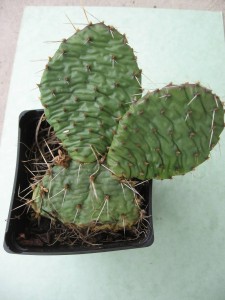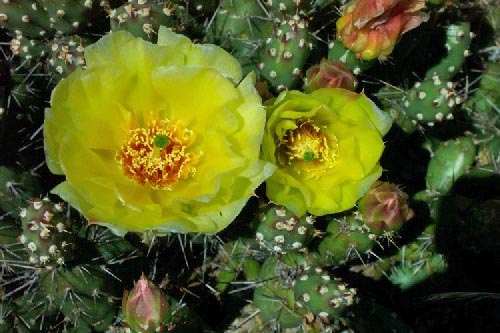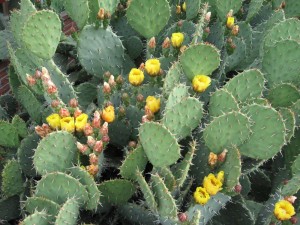Opuntia humifisa
A squat toady of a cactus rarely venturing above one foot. In the winter it gets all crinkled up looking like it needs wrinkle cream. This actually is a survival tool, as the extra skin on the pads can swell after being frozen and have enough elasticity to survive below zero degree temperatures. In the spring and summer it plumps up and is quite attractive. Flowers are a pale yellow
Opuntia fragilis – Brittle Prickly Pear
It used to be widely distributed in the areas found within the Olympic Rain shadow. Sequim, Pt. Townsend and the San Juan Islands. In British Columbia, the plants can be found in the Gulf Islands in the Strait of Georgia.
To those familiar with the large, shrub-like prickly pears of Arizona, Opuntia fragilis would hardly be recognized as a close relative of those impressive plants, but indeed it is! However, it has much smaller pads than most Opuntia species, usually just 1 – 2″ long or occasionally a little longer. The pads are “fat” and can be cylindrical to slightly flattened in shape. Some older references state that the pads are invariably cylindrical, but a thorough inspection of a sample of wild O. fragilis plants will reveal that this definition is too narrow. The pads have spines that may be rather soft and white to more rigid and somewhat golden or brownish in color. The spine color also varies according to the time of year. In June, yellow flowers are produced, but some forms of this species are rather shy to flower.
The names “fragilis” and “Brittle Prickly Pear” are assigned to this plant for a reason; that is, the pad joints are very brittle and apt to break with very little force. With this in mind, and also considering the pads are so small, the plant is seldom able to grow taller than about 6″. Most frequently, it forms broad, low mats on sunny, dry south or southwest facing slopes with gravelly or sandy soil. It is at its best in isolated areas where competition from other plants is minimal.
It blooms but infrequently, as its distribution pattern seems to be from broken off pads. This I can attest to, as I battle with crows all the time. These vicious winged devils routinely come down to pull small pots out of their flats, steal the tags and leave them scattered all over. I HATE them! I finally chili powdered all of these flats, and sprayed them with Cayenne pepper as well.
They moved on to my Cacti flats, and damn it … they stole a couple! When I told that to a friend of mine, she laughed and said that they had just gotten stuck to their feathers. So off they flew with my little cacti attached and now they assuredly have a new home.
Opuntia fragilis was once more common in my own Sequim area, but now is very rare and their seems to be little interest in preserving this unique cactus. The San Juan Islands are doing a much better job of it. Perhaps it is the San Juan Island rabbits distributing the plants around. 🙂
Opuntia cycloides – Hardy Prickly Pear
PLANTING INFO …… Zones 8 and higher Do check out my favorite indoor Cacti!
(C) Herb Senft 2009




Hi, I live in Sequim, WA. & am interested in cultivating the Sequim cactus. Do you know where I might find one?
Yes, I have plenty in all sizes. Some blooming size. Pickup here only. I no longer ship plants.
Not much left of the rest of the nursery inventory – slow selling off as I go.
Hi Herb
I’m here in Sequim as well. I have a small collection of cactus and would love to add the one or two of the brittle and hardy varieties.
So you have any you can part with?
Have plenty. All sizes. Very reasonable. Just keep them on the dry side over winter. Under the East side eaves of a house would be great.
Do you have any Optuntia fragilis left? I would love to try one or two. Thanks,
yes. I have plenty. many different sizes
Looking to purchase Sequim native prickly pear cactus. Have to use credit card. At least 2 plants.
No can do. I am not set up for credit cards. Cash or checks only. And I do not ship.